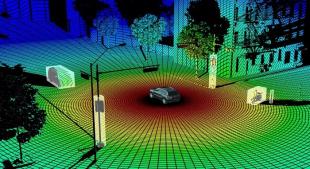This PhD position arises through the award of a five year £5.2M Programme Grant (SPEXS) to the Universities of Edinburgh, Glasgow, Heriot-Watt and Sheffield aiming to significantly expand the operational region of single-photon detectors well beyond silicon's 1000nm wavelength limit into the short-wave infrared (SWIR) region and mid-wave infrared (MWIR) region. By scaling up SWIR and MWIR semiconductor and superconductor single-photon detectors to large area focal plane arrays, the project will produce revolutionary new cameras with picosecond timing resolution which can be used, for example, to see though fog in automotive LiDAR scenarios, as well as allowing imaging and sensing in new applications in environmental monitoring, healthcare, and security and defence.
The PhD student recruited at The University of Edinburgh will build on a world leading position held by the CMOS Sensors and Systems Group in the development of CMOS single photon cameras. The student will join a group of 7 PhD students and 9 postdoctoral researchers working on imaging systems based on single photodetectors.
The PhD project will explore novel interface and timing circuitry to external detector arrays in non-silicon materials systems such as Germanium on Silicon SPAD, InAs avalanche photodiodes and superconducting nanowires provided by Glasgow and Sheffield universities. The CMOS receiver arrays will either vertically stacked or externally wire-bonded to the detectors providing significant opportunities for novel pixel electronics and signal processing techniques in the selected nanoscale technologies. The student will work with Heriot-Watt University to build camera systems around the hybrid arrays and perform electro-optic characterisation of the devices for a range of applications. The student will work alongside an experienced researcher already engaged on the project and interact with a number of other researchers and PhD students working on other aspects of LIDAR.
The PhD student will primarily be engaged in integrated circuit design using industry standard Cadence tools with some responsibilities in the interface, data acquisition and characterisation of the devices. There will be opportunities for visits and exchanges with the laboratories in the academic project partners and a strong interaction with industrial partners is expected in the evaluation of the camera demonstrators.
• Essential
o Master degree in Electronics engineering, Electrical engineering or related discipline.
o Familiarity with IC design flow and tools (Cadence)
o Electronic circuit design knowledge
o Understanding of optical systems and detectors.
o Familiarity in using electronic lab equipment for integrated circuit characterisation.
o Familiarity in Python, Matlab or similar scientific analysis packages for data collection and processing.
o Self-motivated, able to work independently and collaboratively and meet deliverables.
• Desirable
o Understanding of Time of Flight systems and Single photon cameras
o Understanding of image processing techniques.
o Printed circuit board design.
o FPGA usage and hardware description languages.
o Elementary statistics and visualisation of volumetric data.
o Experience of working in a multi-disciplinary team.
**The closing date is 31st August 2021, or until positon is filled**
Further Information:
For more information please visit: https://gow.epsrc.ukri.org/NGBOViewGrant.aspx?GrantRef=EP/S026428/1
The University of Edinburgh is committed to equality of opportunity for all its staff and students, and promotes a culture of inclusivity. Please see details here: https://www.ed.ac.uk/equality-diversity
Closing Date:
Principal Supervisor:
Assistant Supervisor:
Eligibility:
Minimum entry qualification - an Honours degree at 2:1 or above (or International equivalent) in a relevant science or engineering discipline, possibly supported by an MSc Degree. Further information on English language requirements for EU/Overseas applicants.
Funding:
• Applicants with Home tuition fee status: A stipend and Home tuition fees are available for the successful candidate. Please see here for a definition of Home students.
• Applicants with EU Fee status: If an EU applicant is successful and starts BEFORE 1st August 2021, they will be eligible for Home tuition fees and stipend (see above). If an EU applicant is successful and starts AFTER 1st August 2021, they will be eligible for the stipend but an Overseas fee status will apply (see below).
• Applicants with Overseas fee status: Overseas applicants are welcome to apply and will be eligible for the Home tuition fee and stipend, but the top up in fees from Home rate to Overseas rate must be secured by the candidate (either through self-funded means or through external scholarship).



